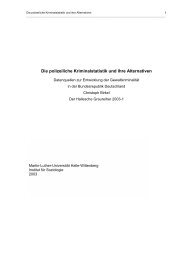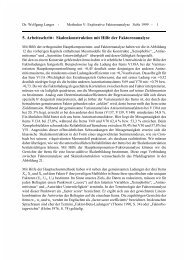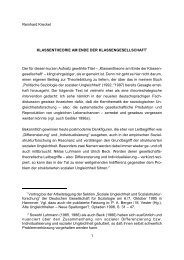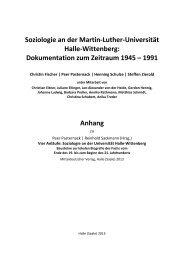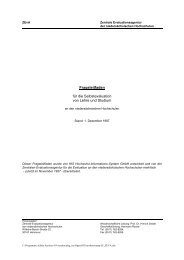EXPLAINING SOCIAL EXCLUSION - Institut für Soziologie
EXPLAINING SOCIAL EXCLUSION - Institut für Soziologie
EXPLAINING SOCIAL EXCLUSION - Institut für Soziologie
Create successful ePaper yourself
Turn your PDF publications into a flip-book with our unique Google optimized e-Paper software.
International Journal of Sociology and Social Policy 100<br />
Volume 21 Number 4/5/6 2001 101<br />
Table 1 (continued):<br />
Predictors of social mobility, pce-model, percentage-effects<br />
Number of preceding<br />
employment history spells<br />
Log-likelihood<br />
Spells<br />
Events<br />
Upward<br />
mobility<br />
21%**<br />
Downward<br />
mobility<br />
n.s.<br />
-13315<br />
63185<br />
Lateral<br />
mobility<br />
17%**<br />
2431 (480 upward transitions; 638 downward<br />
transitions; 1313 lateral transitions)<br />
** = significant on 1%-level; * = significant on 5%-level; n.s. = not significant<br />
Special Collaborative Centre 1 86: Hast German Career Study<br />
employment can prevent one from getting a better Job, but it is not the<br />
start of a downward slope.<br />
What happens after a long single unemployment spell in the next<br />
Job? Individuais stay longer in their next Job. The figures indicate that<br />
people behave in a more risk-averse manner after a spell of long-term<br />
unemployment: lateral (-7%) äs well äs downward mobility transitions<br />
(-5%) are reduced after single long unemployment spells.<br />
What is the effect for your further career by taking a position below<br />
the level of qualification of your certificate? Is it the start of a<br />
downward slope or can people rebalance resources and positions by<br />
moves of counter-mobility? Data suggest the latter: People with a<br />
lower level of position in relation to the level of their certificate are<br />
more likely to make an upward mobility transition (+4%). They are<br />
also less likely to make downward mobility transitions (-3%). Both results<br />
indicate a tendency of successful counter-mobility to rebalance<br />
resources and positions.<br />
Let us now look at structural influences on mobility in the transformation<br />
process. What is the effect of a rise in the general unemployment<br />
level on individual mobility? The data suggest only a weak effect<br />
of the unemployment level on mobility. There is no significant effect<br />
on vertical mobility, only lateral mobility is slightly reduced (-4%).<br />
Modemisation theory suggests a rise of upward mobility by the<br />
enlargement of the tertiary sector. Indeed data support this optimistic<br />
picture. The chance of individual upward mobility rises with more positions<br />
in the tertiary sector (+8.5%) and the risk of downward mobility<br />
is reduced (-6%). A growth of the tertiary sector in Hast Germany is<br />
connected by a better opportunity structure for individual mobility.<br />
Evolutionary Organisation theory argues that formation and closure<br />
of companies influence individual mobility more than the enlargement<br />
or shrinkage of established companies. Our data on the East<br />
German transformation, which in its initial stage was characterised by<br />
high numbers of formation and closure of companies, support these<br />
suggestions. The formation of new companies offers opportunities for<br />
upward mobility (+1%) and lateral mobility (+0.6%), whereas the closure<br />
of companies leads to a rise of downward mobility and lateral mobility.<br />
The results of the event-history analysis on the effect of unemployment<br />
for mobility with respect to exclusion theory is rather clear<br />
cut: Unemployment is a transitory element of mobility paths. Rather<br />
than determining the direction of social mobility, it is a rather neutral<br />
switch preceding mobility in all directions. The only result that would<br />
fit the usual exclusion discourse is that people with a long record of cumulative<br />
unemployment are less likely to make upward mobility transitions.<br />
In the event history analysis, we also find some hints that<br />
individuals may not simply be the victims of unfavourable conditions;<br />
they try to actively cope with their position. So, after long-term unemployment<br />
spells, they try to hold on to their new Job longer than people<br />
without this experience.<br />
Results of an optimal matching analysis<br />
Before we refute exclusion theory with the empirical results of the<br />
event history analysis, let us be cautious and question the method used.<br />
Maybe there are limits to the method used that prevent us from discovering<br />
exclusionary phenomena: The focus of event-history analysis is






